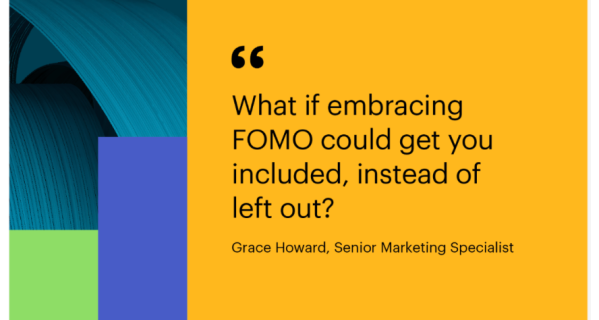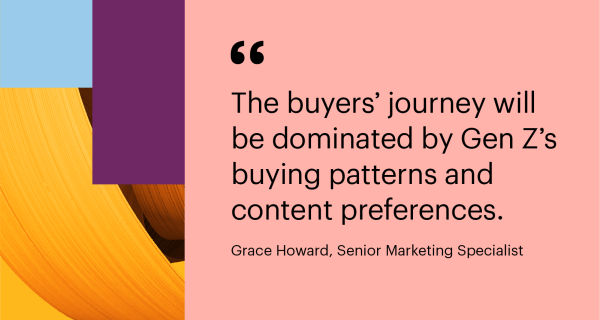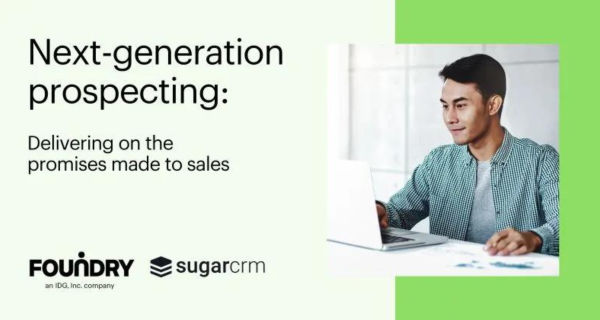An intro to account-based marketing
Account-Based Marketing (ABM) is one of the most widely mentioned terms in the world of B2B marketing. Although you might be familiar with the term ABM, you might not know the nitty gritty. If you’re looking to fill your pipeline with high-fit accounts and prove your ROI, you might want to keep reading.
So what exactly is Account-Based Marketing? Why do you need it? And how do you get started? We’re answering everything you need to know in our ABM for beginners guide, plus a few tips from B2B industry experts!
What is account-based marketing?
Account-Based Marketing is a B2B marketing strategy in which sales and marketing teams work closely together to target, reach, and close deals with high-fit accounts.
ABM prioritizes quality over quantity, so in an account-based strategy, sales and marketing teams allocate more resources and time towards high-value, high-intent target accounts. When high-value buyers show interest in your product early in their purchase journey, account-based technology can put these signals right at the fingertips of your marketing and sales organizations. No longer just a buzzword, enthusiasm for ABM is evident among tech marketers with 91% of businesses running programs for at least six months.
ABM vs. traditional selling
What makes ABM different from other demand generation strategies?
Traditional selling takes a much broader approach to qualifying accounts. Often this consists of qualifying as many accounts as possible (fit or unfit) into your pipeline. Without an account-based strategy, marketing teams are often focused on lead volume over quality, which can create friction with the sales team.
While other demand generation strategies aren’t necessarily “ineffective”, you won’t have the same account-level engagement as you see within ABM, or the strong alignment of your sales and marketing teams around the same goals.
Compared to traditional selling, ABM takes a different approach to targeting accounts. Rather than focusing on the quantity of accounts in pipeline, ABM prioritizes the quality of accounts – so teams can focus their efforts on providing high-fit accounts with relevant content and personalized messaging. The idea behind ABM is to start out the buyer’s journey by identifying your target accounts and engaging them with personalized campaigns to build strong relationships that will have a higher chance of converting into closed-won deals for your business!
Why you should consider ABM for your marketing strategy
There is a lot to consider before making the jump into ABM. Having questions is normal, and in fact welcomed. Some common ABM questions we hear from B2B marketers before getting started are:
- How do I influence buyers early?
- How do I measure the most valuable deals in the pipeline?
- How do I guide the entire purchase group towards reaching a consensus?
The good news is (if you keep reading) we’ve got all these answers and more in this guide.
There’s no shortage of benefits from an account-based strategy. There are many reasons why you should consider ABM for your business. Just to name a few:
- Focuses your resources on high-fit accounts
- Reaches prospects earlier in the buyer’s journey
- Aligns marketing and sales teams
- Shortens long sales cycles
- Identifies high-fit accounts more likely to purchase and drive new opportunities for sales
- Boosts ROI and accelerates pipeline
- Keeps your brand top of mind among prospects
We could go on, but by the end of this guide, we hope you’ll have more than a few reasons for implementing your own ABM strategy.
What model of ABM is right for you?
When asking, “What model of ABM is right for me?”, consider what your goal is for your ABM program. Let’s examine each model and why it might be a good fit for your organization’s goals.
Large account
Large account ABM models are used to target just a few very large customers.
If you’re looking to land your first enterprise accounts, move up market, or expand an existing keystone account you have because there is a lot more revenue potential there – this model might be for you. In a large account model, there should be heavy focus on developing content and programs that allow you to introduce those new opportunities to key decision makers in that account.
Learn more about how to launch a 1:1 ABM strategy.
Named account
Named account ABM models are primarily used to target hundreds or even thousands of accounts (depending on the size of your sales team).
If your sales team is targeting a large number of accounts, you can use the named account ABM model to better convert those accounts. This model is especially useful when your company has introduced new products or is entering a new market.
Focused demand gen
Focused demand generation ABM is when you take account-based tactics and apply them to your existing marketing channels.
For example, say you don’t feel the accounts you’re going after fit your ICP, you can use an account-based approach to start segmenting and spending your resources on accounts that best fit your ICP. This model is about improving the efficiency of your go-to-market strategy by prioritizing and segmenting accounts. If you are looking to focus your resources and reduce spend, this might be for you!
Learn more about the different models of ABM strategy.
Elements of a successful ABM strategy
What are the elements of a successful ABM strategy? Let’s look at a few pieces that are key to having a killer ABM strategy.
Intent data
Intent data is a hot topic in the B2B space, and for good reason. Today’s B2B buyer is better informed than ever before, with 87% of B2B buyers who would prefer to self-serve all or part of their buying journey. Why should you care? Because by the time a buyer fills out a contact form from your website, they are likely in the final stages of their buyer’s journey. Rather than waiting on buyers to raise their hands through form-fills, integrating intent data into your ABM strategy allows you to understand your engaged audience early in their buyer’s journey and gives you insight into what content they are interested in as well as what messages will best resonate with them.
Here are just a few places you can find top tier intent data for your ABM strategy:
- G2 – Sourced from the world’s largest software marketplace
- Bombora – Identify accounts surging on relevant topics with Bombora Company Surge®
- LeadSift – Take the guesswork out of prospecting with contact level intent data
- KickFire – Tap into intent data across your website and enhance your account-based strategies
(Quick plug, Foundry ABM has integrations for all of the above.)
Learn how to optimize your ABM strategy with intent data.
Personalization
Including website personalization in your account-based strategy allows you to serve relevant and customized content that speaks directly to your target audience. In fact, here at Foundry we found that accounts with personalized web experience are:
- 20% more likely to convert
- 50% more likely to visit your site again
- 150% more engaged
To better engage your target audience, create dynamic web experiences by serving relevant messaging, offers, imagery, and content. Here are a few ways you can deliver personalized content within your ABM strategy:
- Display Ads – Display ads can be personalized to speak directly to the pain points of potential customers.
- CTAs – Overlay custom cards, headers, footers with embedded offers, videos or forms targeted to specific website visitors. Use CTAs to create an action that aligns with the website and display advertising personalizations.
- 1:1 Landing Pages – Web pages give you a lot of freedom in the content you upload and the specific messaging you want to use. A 1:1 landing page is a way to mix and match content for your ICPs in a way that feels personal and high-value.
Learn more about how to deliver a personalized experience in your ABM campaigns.
Sales activation
Every company would like to shorten their sales cycle if they could. Account-based marketing has been shown to shorten sales cycles– but how? ABM identifies accounts earlier in the buyer’s journey, enabling your sales outreach to be extremely personalized with catered messaging and content even before a prospect fills out a form. Sales teams become more productive because their TAM (total addressable market) is being prioritized with data, and marketers dedicate time to warming up high-value accounts before activating sales plays. This visibility into key account insights allows marketing and sales to tightly align on messaging.
Orchestration
Once you have a well defined audience and tactics to engage them, the most significant hurdle in your way is time. To set up campaigns with ads, personalization, and sales activation to reach the right accounts at the right time would be a hugely manual and time-intensive process. In comes orchestration. Orchestration allows you to combine your account-based audience with dynamic criteria such as intent data signals to trigger multi-channel ABM tactics automatically. As such, predictive orchestration is a powerful tool for scaling account-based marketing programs.
Learn more about the power of predictive orchestration, and how to get started.
How do you get started with ABM?
Now that we’ve covered the basics, ready to get started with your own ABM program?
Don’t worry, we’ll walk you through the setup and let you in on a few of our best practices.
Define your ideal customer profile
Without an Ideal Customer Profile (ICP), ABM becomes quite impossible.
What is an ICP? – Simply put, identifying your high-fit customers.
An ICP is a hypothetical description of the type of buyers in your market that would benefit most from your product or service. Your product won’t be the perfect fit for everyone, and that’s okay. At the end of the day, you want to make sure your customers will be successful with your product. Organizations with a strong Ideal Customer Profile achieve 68% higher account win rates.
Ideal customer profiles help your marketing team get a picture of exactly who you’re creating content for. The better you understand your customer, the more you can cater messaging to the audience you’re engaging with.
ICPs are defined by factors including their relative career stage, their familiarity with your service offerings, their pain points, and their motivation. For example, an ICP buyer persona for a SaaS company might be a Tech Newbie. Here we might say that the ‘Tech Newbie’ is the earliest in their career, not familiar with your service offerings, and their pain points may be issues like learning the systems they work in, lack of efficiency in their workflows, and more. Knowing your customer fits into this ‘Tech Newbie’ ICP, you can now place relevant content in front of them, increasing the chances of engagement and keeping your brand top of mind.
Select your accounts
Once you’ve identified your ICP, it’s time to select which target accounts you should go after. Audiences are the most important piece to a well-thought-out ABM strategy. The best source for target accounts depends on your specific business objectives and marketing goals.
Consider these tips when selecting your audience:
- When targeting prospects, begin with a list created by sales and then obtain a sign-off from the strategy team.
- When targeting existing customers, ask client success for a list of strategic accounts for upsell, cross-sell, and advocacy.
- If ABM aims to improve existing demand generation campaigns, start with account lists from marketing automation.
- Still struggling to put together a list? Find accounts based on a firmographic profile of customers or hire a vendor for propensity modeling
Build your audience segments
Once you’ve selected your accounts, you can start building your audience segments. This is a crucial step to getting any ABM program off the ground. A best practice in segmenting your audience is to segment by account size and purchase stage.
Segmenting by account size
Different account sizes need different levels of attention. Instead of the average 6.8 stakeholders per purchase, enterprise sales can involve 20+ stakeholders, according to Foundry. The larger the account, the higher the expectation and need for personalization.
- Large Accounts – require the most one-on-one attention. Large accounts typically have lots of buying centers with many stakeholders. Large accounts raise unique problems that require customized solutions, requiring hyper-targeted campaigns.
- Small Accounts – can be targeted in segments. Small accounts will have fewer stakeholders involved and tend to require less attention. Marketers often scale one set of messaging and CTAs to reach tens of thousands of small accounts with similar needs.
- Midsize Accounts – aren’t large or small. They have some custom needs but move quickly with fewer stakeholders.
Segmenting by purchase stage
Not all prospects are in the same stage of the buyer’s journey and should be treated according to the stage they are currently in.
- Prospects – early in the buyer’s journey. Prospects are still defining their problems and what solutions they need. During this stage spreading brand awareness and winning share of mind is important.
- In Pipeline – in pipeline accounts have a clearly defined set of problems, and are researching a specific set of solutions.
- Customers – customers may have already signed a contract with you, but are in essence, your most valuable segment – customer value can be expanded with retention year-to-year, upsell / cross sell opportunities, and with providing references. Customers should be provided with opportunities for continuous education, kept informed about new product updates, and should be consulted for their personal experiences with your product.
Measure and optimize
The best way to really have an understanding of your company’s ABM success is knowing which account-based marketing program metrics to track and report on. ABM isn’t about counting the number of leads you have but rather, assessing their value to your pipeline. By shifting your measurements of success to KPIs more associated with actual revenue impact, account-based marketing teams are more likely to have a positive impact on revenue.
According to Foundry Chief Customer Officer, Andrew Mahr, “The most important thing about ABM metrics is that sales and marketing need to be tied to the same KPIs — not fighting different battles with different definitions of success. When it comes to picking that metric, there are two I think work best — opportunity rate in target accounts & revenue per target account.”
Here’s a couple more key ABM metrics that we recommend tracking:
- Demand Gen by Account: Measure lift in target account engagement with channels such as email, web, and display-ads
- Pipeline Creation: Measure growth in the percent of in-target opportunities created
- Pipeline Influence: Measure growth in the percent of in-target deals closed
Best practices for launching a successful ABM program
Congratulations, you’re ready to get started with ABM! To really help you get your program off the ground, here are a couple of tips from industry experts with years of experience under their belt and thousands of successful ABM campaigns.
What’s your advice to those just starting out with ABM?
“Start with customer expansion campaigns. It removes some of the challenges that new logo campaigns have (e.g. lack of account insights, trouble mapping the account) and so lets marketing and sales teams focus on collaborative campaign design and probably benefit from shorter sales cycles.” – Andrew Mahr, Foundry Chief Customer Officer
What’s the biggest challenge you see people face with ABM programs?
“The biggest challenge I see people face with ABM programs is when there’s no buy-in from the sales team or the marketing team is getting lost in ads and forgetting the other channels and tools critical to ABM program success.” – Customer Success Manager, Foundry
See more about best practices from our ABM AMA (Ask Me Anything).
How to select the right ABM platform for your business
Selecting the right ABM platform for your business is a large commitment, and requires company-wide input and backing. Before you select your vendor, here are a few tips to help you pitch ABM to your leadership team, and select your martech stack.
- Have a plan, know your goals, and how ABM will fit into your existing strategy.
- Ask yourself, does this software integrate well with your existing tech stack?
- Talk to other teams! ABM is for sales just as much as it is for marketing.
Is ABM software right for you? Check out the ABM Buyer’s Guide designed for senior marketing professionals who are assessing the suitability of ABM platforms for their organization.
Conclusion
As a maturing field, the account-based marketing landscape can be quite overwhelming for beginners. Above all else, account-based marketing is about getting sales and marketing teams on the same page about who to target, and what success looks like. Beginners can dip a toe in the ABM waters by starting with sales and marketing alignment and a target account list, before diving into the deep end with account-based marketing software.
If you think it’s time you learned more about account-based marketing software, check out the Foundry ABM platform with one of our ABM experts.






